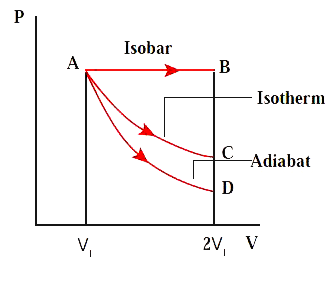One mole of an ideal gas intially kept in a cylinder at pressure 1 MPa and temperature 27∘C is made to expand until its volume is doubled.
(a) How much work is done if the expansion is (i) adiabatic (ii) isobaric
(iii) Isothermal?
(b) Identify the process in which change in internal energy is least and is maximum.
(c) Showeach process on PV diagram.
(d) Name the processes in which the heat transfer is maximum and minimum. (Take γ=53andR=8.3J mol−1K−1)
(a) (I) In an adiabatic process the work
done by the system is
Wadia=μRγ−1[Ti−Tf]
To find the final temperature Tf, we can use adiabatic equation of state.
TfVγ−1f=TiVγ−1i
Tf=Ti(ViVf)γ−1=300×(12)23
=0.63×300K=189.8K
W=1×8.3×32(300−189.8)=1.37kJ
(ii) In an isobaric process the work done by the system
W=PΔV=P(Vf−Vi)
and Vf=2Vi so W=2PVi
To find Vi, we can use the ideal gas law for initial state. PiVi=RTi
Vi=RTiPi=8.3×3001×10−6=24.9×10−4m3
The work done during isobaric process,
W=2×106×24.9×10−4=4.9kJ
(iii) In an isothermal process the work done by the system.
W=μRTln (VfVi)
In an isothermal process the initial room temperature is constant.
W=1×8.3×300×ln(2)=1.7kJ
(b) Comparing all three processes, we see that the work done in the isobaric process is the greatest, and work done in the adiabatic process is the least.
(c) The PV diagram is shown in the figure.

The area under the curve AB = Work done during the isobaric process The area under the curve AC = Work done during the isothermal process The area under the curve AD= Work done during the adiabatic process From the PV diagram the area under the curve AB is more, implying that the work done in isobaric process is highest and work done in adiabatic process is least.
(d) In an adiabatic process no heat enters into the system or leaves from the system. In an isobaric process the work done is more so heat supplied should be more compared to an isothermal process.
Topper's Solved these Questions
- HEAT AND THERMODYNAMICSBOOK - NCERT TAMILCHAPTER - HEAT AND THERMODYNAMICSEXERCISE - EVALUATION (MULTIPLE CHOICE QUESTIONS)
15 Videos
- HEAT AND THERMODYNAMICSBOOK - NCERT TAMILCHAPTER - HEAT AND THERMODYNAMICSEXERCISE - EVALUATION (Numerical Problems)
13 Videos
- GRAVITATIONBOOK - NCERT TAMILCHAPTER - GRAVITATIONEXERCISE - ADDITIONAL EXERCISES
4 Videos
- KINEMATICSBOOK - NCERT TAMILCHAPTER - KINEMATICSEXERCISE - EXERCISE (IV. Exercises )
20 Videos
Similar Questions
In a cylinder, 2.0 moles of an ideal monatomic gas initially at 1.0×106 Pa and 300 K expands until its volume doulbles. Compute the work done if the expansion is (a) isothermal, (b) adiabatic and (c ) isobaric.
View SolutionIn a cylinder, 2.0 moles of an ideal monatomic gas initially at 1.0×106 Pa and 300 K expands until its volume doulbles. Compute the work done if the expansion is (a) isothermal, (b) adiabatic and (c ) isobaric.
View Solution
Knowledge Check
Two litres of an ideal gas at a pressure of 10 atm expands isothermally at 25∘C into a vacuum until its total volume is 10 litres. How much heat is absorbed and how much work is done in the expansion ?
A10 J, 10 JB8 J, 10 JC18 J, 0 JD0 J, 0 JOne mole of and ideal monoatomic gas is compressed isothermally in a rigid vessel to double its pressure at room temperature, 27∘C . The work done on the gas will be :
A300 R ln 7B300 R ln 2C300 RD300 R ln 6One mole of an ideal gas expands isothermally to double its volume at 27∘C . The work done by the gas is nearly
A2760calB414calC1380calD600cal
Two litres of an ideal gas at a pressure of 10 atm expands isothermally at 25∘C into a vacuum until its total volume is 10 litres. How much heat is absorbed and how much work is done in the expansion ?
View SolutionTwo litres of an ideal gas at a pressure of 10 atm expands isothermally at 25∘C into a vacuum until its total volume is 10 litres. How much heat is absorbed and how much work is done in the expansion ?
View Solutionone mole an ideal gas having volume 2 litre and at a pressure of 10 atm expands isothermally at 25 °C into a vacuum until its total volume is 10 litres. How much heat is absorbed and how much work is done in the expansion ?
View SolutionOne mole of and ideal monoatomic gas is compressed isothermally in a rigid vessel to double its pressure at room temperature, 27∘C . The work done on the gas will be :
View SolutionThree moles of an ideal gas at 127∘C expands isothermally untill the volume is doubled. Calculate the amount of work done and heat absorbed.
View Solution
